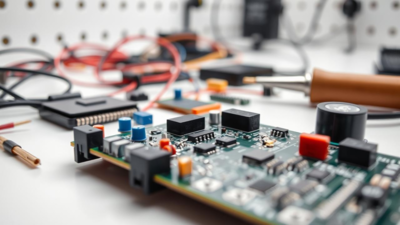Government unveils Rs 23,000-crore electronics components manufacturing scheme to boost domestic production

NEW DELHI: The Government has released regulations for applications under the Rs 23,000-crore Electronics Components Manufacturing Scheme (ECMS), aimed at boosting domestic value addition in electronics production.
Union Electronics and IT MinisterAshwini Vaishnaw revealed that firms with strong local design capabilities and ‘six sigma’ quality standards will be key evaluation factors. Companies lacking domestic design teams might be “left out” of the “phenomenal change” expected in India’s electronics sector over the next five years, according to a report by The Economic Times.
Applications for the six-year scheme will open on May 1 through an online portal.
The Union Cabinet, chaired by the Prime Minister, had approved the ECMS earlier this month. The initiative seeks to attract substantial domestic and global investments, develop robust manufacturing capabilities, and integrate Indian companies into Global Value Chains (GVCs).
S Krishnan, Secretary of the Electronics and IT Ministry, asserted that the scheme is timely, coinciding with geopolitical shifts that could redefine global value chains. It is expected to increase India’s share in global electronics manufacturing from 3 per cent to 8 per cent over six years, according to him.
The programme targets Rs 59,350 crore in investments, aims to create 91,600 direct jobs, and projects production worth Rs 4,56,500 crore. It offers a mix of turnover-linked and capital expenditure incentives, depending on component type, with employment generation tied to both incentive structures.
ECMS covers sub-assemblies such as display and camera modules, core components like multilayer PCBs and lithium-ion cells, specific bare components including HDI and MSAP PCBs, as well as supply chain infrastructure and manufacturing equipment.
Application windows differ: three months for sub-assemblies and bare components, and two years for supply chain and capital equipment categories.
Atul Lall, vice chairman and managing director of Dixon Technologies, confirmed plans to invest significantly in at least four component categories under the scheme.
Meanwhile, industry bodies highlighted the need for international collaborations and strong state partnerships to strengthen the electronics ecosystem.
Additionally, Vaishnaw noted India’s electronics production and export growth—both witnessing five- and sixfold increases respectively over the past decade—adding momentum to the ECMS.
India’s electronics production has surpassed Rs 11 lakh crore (approximately $129 billion) annually. The country is targeting $300 billion by 2026 and $500 billion by 2030-31 in domestic electronics production.
Separately, the government announced Bengaluru-based Sarvam AI as the first startup selected to develop an indigenous foundational model under the IndiaAI Mission.
Pankaj Mohindroo, chairman of the India Cellular and Electronics Association (ICEA), predicted that states would launch competitive initiatives to attract investments. He cited the mobile industry’s current $62 billion production base, suggesting ECMS will further strengthen India’s components and sub-assembly ecosystems.
Ashok Chandak, president of SEMI India and the India Electronics and Semiconductor Association (IESA), described the scheme as critical for boosting manufacturing capabilities while complementing the India Semiconductor Mission.
The ECMS outlines various investment thresholds by component type, offering turnover-linked incentives for investments between Rs 50 crore and Rs 500 crore, alongside additional capex incentives for selected components.





